Jonathan Pinnock's Blog, page 4
March 23, 2020
Introducing GURTL
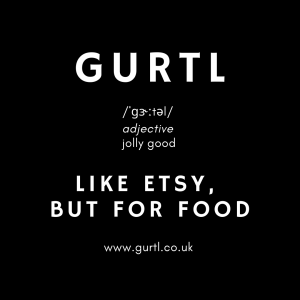
For once, I’m not about to bang on about writing. It’s not that writing – or indeed the arts in general – aren’t important during a time of crisis, because they are probably more important than ever in keeping our spirits up. But I wanted to use this occasionally-viewed space to say a bit about my new venture GURTL.
What set it off was me worrying about some of our local shops down here in Somerset and how they’re going to cope over the next few difficult months. Because they tend to rely on regular physical customers dropping into their shop ever week, and that’s going to get increasingly difficult as this thing goes on. Typically they don’t have any internet presence at all, or if they do, it’s not geared up to actually sell anything directly.
But it struck me that with a bit of ingenuity I could actually put together a platform that would enable them – and in fact any such shops elsewhere in the UK – very quickly to get online, and that is how GURTL came to be born. (As an aside, I would point out to anyone else who’s thinking of doing something like this that it’s REALLY important to check the Urban Dictionary before you pass the button. We very nearly went live with a name that has not one but THREE different obscene and fully-googleable meanings, and I had to reconstruct everything from scratch.)
I have no idea if this is going to be remotely useful. My instinct says it is, but I’m not always right with these things. But at least it’s given me something concrete to do over the last few days instead of sitting at my desk scrolling through social media and fretting about the world.
Do please take a look at GURTL, and if you think this might be helpful, spread the word. We’re only doing businesses in the UK at the moment, because even that could potentially overwhelm us.
The post Introducing GURTL appeared first on Jonathan Pinnock - Writer of Stuff.
March 17, 2020
What I Read in February
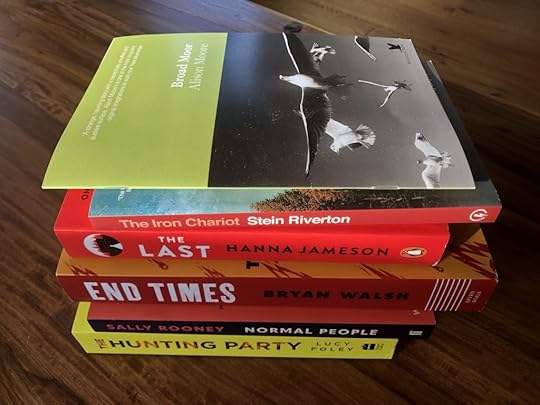
Further to my last post, I regret to inform you that Project X has – to no-one’s surprise – progressed no further, although I have dug out a couple of other ancient abandoned projects in the hope of actually doing something with them. More on that soon, if I fail to find a way of postponing work on them. But these are strange times, and I seem to be swinging wildly between feelings of “Well we might as well get this done, seeing as we’re going to be stuck in here for a while yet” and “Oh God, there’s no point in doing anything, is there?” I suspect I am not alone in this.
Last week was mostly the second, although this week seems to have a bit more of the first type of vibe to it so far, although that may simply be just because the sun’s chosen to shine. Who knows?
Anyway, here are some books that I read in February.
The Hunting Party by Lucy Foley. Massively successful whodunit – actually, for most of the book, a whodunwho, if you will – involving a cast of deeply unlikeable yuppies renting an isolated house in Scotland over New Year. Great fun, although I did feel the wheels came off slightly towards the end, because there was one thing that I was asked to believe that I just could not buy into. But a total page turner, nonetheless.
Normal People by Sally Rooney. I very nearly passed over this one after reading Rooney’s Conversations with Friends last year, because that one seemed to be about a bunch of four people who were each competing to be the most irritating. However, I’m glad I didn’t, because this was an absolute delight: two engagingly flawed main characters, trying to navigate their way through twenty-first century relationships. Rooney’s writing takes you right up close and I felt really invested in them. I was quite sad when it ended.
End Times by Bryan Walsh. Well I definitely picked the right time to read this one, didn’t I? This was basically a guide to all the ways in which the human race can come to an end, from climate catastrophe through killer robots to, yes, out of control viruses. Very thorough, but also very readable, if somewhat scary. In case you’re interested, Walsh seems to rate genetically-engineered bugs the most likely way for us all to check out, which is nice.
The Last by Hanna Jameson. [Possible spoiler alert] I felt a bit cheated by this, as the blurb suggested it was going to be a kind of post-apocalyptic ‘And Then There Were None’, which sounded a lot of fun. But it wasn’t that at all. If I’d been sold the book as a study of what might happen if you were caught in an isolated hotel in the middle of Switzerland after the Bomb dropped, I think I’d have enjoyed it much more, because there were some interesting characters and a few genuinely shocking moments in it. But the ultimately inconsequential murder sub-plot somehow got elevated to the back cover and derailed my expectations.
The Iron Chariot by Stein Riverton. Otherwise known as the first-ever Scandi Noir novel. This was a most enjoyable read – very atmospheric and full of odd red herrings. The book was something of a period piece, obviously being written for a 1909 readership rather than a 2020 one, and I’d worked out what was happening well before the end, but that didn’t really spoil it.
Broad Moor by Alison Moore. I think Moore’s ‘Small Animals’ (published, like this, as a Nightjar chapbook) is one of my all-time favourite stories and I’m always on the lookout for more of her work. Her stories are characterised by an air of unspecified, brooding menace that intensifies into something deeply sinister right at the very end – often in the very last sentence – and Broad Moor is a terrific example of this.
The post What I Read in February appeared first on Jonathan Pinnock - Writer of Stuff.
March 6, 2020
How DOES Anything Ever Get Written?
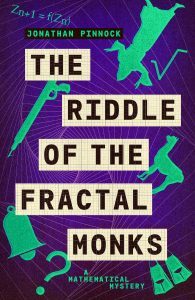
The post I was planning to write in the next day or so was the usual ‘What I Read in the Previous Month’ one (and there’s some interesting stuff in there, I can tell you), but something else important struck me and I thought it might be a good time to share it with you. And seeing as it’s intended to provoke a response or two – and hence might possibly generate a bit of traffic – I thought there was no harm in putting up the cover of my forthcoming book once again – especially since it’s just gone live on NetGalley,
This post was triggered by a couple of things that happened recently. First of all, there was a change in my schedule. Book Four in the Mathematical Mystery series, Bad Day in Minsk, had been tentatively lined up for publication in September of this year. I’d readily agreed to this, but by the time the end of February was looming, there was somewhat less of it written than I’d anticipated. So I was more than a little relieved when publication was put back to 2021, enabling me to finesse my lack of progress and agree that yes, this was obviously disappointing, but I could probably cope with a later deadline.
Of course what happened next was that my mind set to work wondering what I could do with all the extra time I now had – ignoring the obvious one, which was ‘Get on and write Bad Day in Minsk at a sensible leisurely pace, you idiot, rather than ending up frantically scribbling away like some NaNoWriMo entrant who’d forgotten to get going until the third week.’
Which brings me on to the second thing that happened recently. I had an idea. An idea for a conventional high-concept thriller. The sort of thing that wouldn’t look out of place in the WH Smiths at Heathrow. Not only that, but I’d actually spent most of February working it out in my head to the point where I actually had pretty much the whole plot laid out. This is not my usual style at all, so it was obviously SIGNIFICANT. Now don’t get me wrong, I have no desire to abandon the Mathematical Mysteries. I’ve grown to love those characters and the situations they find themselves in (well, someone has to) and there’s so much more I want to do with them. But I do also fancy stretching out a bit, just to see if I can.
So the obvious thing to do was take advantage of my new found extra time and spend maybe a month of it starting work on Project X, just to see if it really has legs. Seems fair, right?
Wrong.
Here’s the thing. Even after having had half a dozen full-length books published and one more commissioned, I find it impossible to write something without some kind of external influence bearing down on me. Is it just me, or does the whole idea of spending time working on some unasked-for project seem so massively self-indulgent and embarrassing that I’ll do almost anything to avoid it? So, yes, I am currently doing anything to avoid writing a single word on Project X. And as my month on that is scheduled to run before I really get stuck into Bad Day in Minsk, that means I’m not doing a lot on that one either.
So how DOES anything ever get written?
Well, I can tell you how all my other full-length books got written. Here goes…
Professional DCOM Application Development (yep, let’s start at the very beginning) – I pitched an idea to a publisher and got contracted to write it. Incidentally, I still got paid more for that than anything else I’ve written, although it was a LOT less fun.
Mrs Darcy versus the Aliens – Well, I staggered to around 10K words thanks to the goodwill of the Verulam Writers’ Circle, the writing group I was in at the time, but the only way I actually finished it was to start serialising it online. By the time I ran out of that initial 10K words, I’d gathered sufficient of a following that I was obliged to continue. Also, I was enjoying the reactions I was getting.
Take It Cool – Once again, the initial impetus was my writing group, and with their encouragement, I got to a point where I could try pitching it to agents and publishers, given that I’d heard that non-fiction books didn’t need to be complete to get commissioned. This turned out to be completely wrong, as no-one would take it on without knowing whether or not I’d actually tracked Dennis Pinnock down, and at the time I had no idea if I would. I did, however, get a commitment from one publisher that they’d give it a serious look when I’d finished it, and on that basis I went ahead and finished the damn thing. In the end, they couldn’t see a way to market it, so I ended up taking it elsewhere. But they did at least force me to finish it.
The Truth About Archie and Pye – OK, this is where things started to get desperate. The reason I wrote it is that I’d paid a large amount of money to do the Creative Writing Masters at Bath Spa and I needed a project. So I basically wrote it to avoid wasting all that cash.
A Question of Trust – I wrote this because I had a contractual commitment to write the second book that Farrago had commissioned when they bought The Truth About Archie and Pye.
The Riddle of the Fractal Monks – I wrote this because I had a contractual commitment to write two more books in the Mathematical Mystery series.
Bad Day in Minsk – I will write this for exactly the same reason.
See the common theme? In all of these cases, I have needed an external agency to give me a reason – an excuse, even – to spend time writing a book. Clearly, ‘I am writing this book because I have a hunch people will want to read it’ is not sufficient. It has to be ‘I am writing this book because someone more important than me has commissioned it and therefore I have a contractual commitment to keep.’
Now I think I know the reason for this. It’s because first drafts are universally terrible, and the only way to counter the feeling that ‘this thing is a crock of shit and, verily, great and marvellous is the smell thereof’ is to add ‘but the Lord hath commanded that somehow this crock of shit must nevertheless be transformed into the most precious of stones.’ Which is great if there happens to be a (non gender specific) Lord around to do the commanding. But what if there isn’t?
Is it just me?
So what am I going to do about Project X? Will it go the same way as all the other Projects X‘s that have fallen by the wayside over the years? What do other people do?
The post How DOES Anything Ever Get Written? appeared first on Jonathan Pinnock - Writer of Stuff.
February 12, 2020
What I Read in January
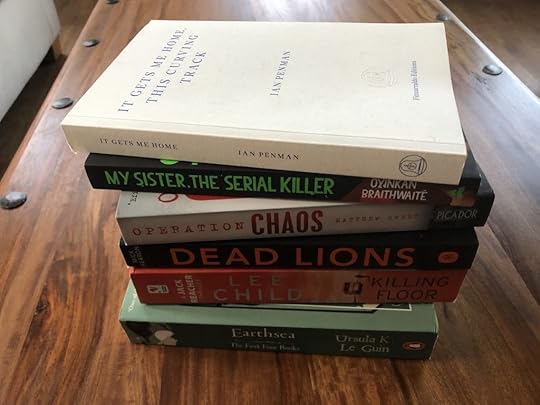
Well, the reading programme got sort of back on track in January, after a disastrous last two months of 2019. But before we dive into this lot, I’d like to bring your attention to an interview I did with Teika Bellamy of The Book Stewards, where we talk about how I got into writing, how writing stuff like poetry and flash fiction informs novel writing and how I somehow managed to get several publishing deals without having an agent.
Right. What I read in January. Here we go…
A Wizard of Earthsea by Ursula Le Guin. Ah. The more astute of you may spot that this is a bit of a cheat, since the book in the picture above is actually a compendium of the first four Earthsea books. However, I regret to inform you that I only made it to the end of the first one, and even that took me a looooong time. If I were to be brutally honest, I might also add that I got to within 30 pages of the end of it and almost didn’t bother reading the rest. This is basically how I ended up reading bugger all in November and December, by the way AND I FEEL TERRIBLE ABOUT THIS, because Ursula Le Guin is a total icon of fantasy writing and everyone goes on about how wonderful her books are. But I have to say that I found it a hell of a slog to read. I didn’t relate to any of the characters, the quest didn’t seem to make much sense and the writing was way too portentous to be remotely enjoyable. Someone please tell me I started with the wrong book, because I hate feeling left out.
Killing Floor by Lee Child. A few years back, a friend of mine lent me one of the later Jack Reacher books. I said thank you through gritted teeth, because I had loads of other books in my TBR pile to get through first and I put it to one side. However, when I eventually got round to reading it, I absolutely loved it and promised myself that one day I’d get round to reading the lot. Well, that day finally arrived in January, and Killing Floor did not disappoint one bit. No frills, no flowery writing, no flannel. Just loads of action, some neat twists and a straight down the line enigmatic lone wolf hero. Also, as my friend pointed out to me, just after he’d read one of my books, no bad language. Spectacularly violent, though, so swings and roundabouts. I’m looking forward to the next one already.
Dead Lions by Mick Herron. Book Two in the Slough House series and this was just as much fun as the first one, albeit a tad little less plausible in the plot department. I’m really enjoying these.
Operation Chaos by Matthew Sweet. The true, bonkers story of Lyndon LaRouche and his mad bunch of followers. One for the fans of conspiracy theorists of the kind that Jon Ronson tends to dig up, although I did sometimes get the impression that Sweet was struggling to marshal the sheer volume of information here. There are so many protagonists, each with their own individual brand of weirdness, that the whole thing gets more than a little exhausting by the end. But an entertaining read nonetheless.
My Sister: The Serial Killer by Oyinkan Braithwaite. Oh, this was fun. Snappy, tasteless but so true about sibling rivalry and loyalty, I read this pretty much in a single sitting. Also, really great to see a comic novel like this written by a woman of Nigerian heritage and set in Lagos. More of this kind of thing, please.
It Gets Me Home, This Curving Track by Ian Penman. Collected essays by one of our most eminent music critics. Fascinating series of long-form pieces on the likes of Sinatra, James Brown, John Fahey and Prince, which – as all the best writing on music should do – is going to send me back to the source material to listen again with new ears.
The post What I Read in January appeared first on Jonathan Pinnock - Writer of Stuff.
February 3, 2020
New Trailer and Other Stuff
Long time followers may remember that I’m a bit of a fan of book trailers. Yes, I know conventional wisdom is that they’re a waste of time, but I suspect that most of them tend to be ignored because they’re a bit dull. Mine, on the other hand, tend to get ignored because a) they’re a bit odd and b) my marketing footprint is about the size of a toddler’s first pair of Start-Rite sandals.
So here’s another one for you to ignore. It’s for my new book THE RIDDLE OF THE FRACTAL MONKS, which is published by the Farrago imprint of Duckworth Books on April 16th. Do take a look and if you like it, share it with your friends. If you hate it, share it with them as well. It’s the views I’m after. (BTW that really is me singing.)
In other news, I did a sort of interview with NFReads, in which I talk about creativity, inspiration and unexpected things you can do with fourteen foot of garden hose.
Finally, I was tagged out of the blue by the excellent Slow Culture magazine to alert me to their extremely flattering review of LOVE AND LOSS AND OTHER IMPORTANT STUFF. So much has happened since that book came out three years ago that I’d almost forgotten I’d written it. I think my favourite thing about having books published is hearing from complete strangers, and I’m completely baffled by a view that was circulating on Twitter this week that it was somehow bad to tag authors into good reviews. Sure, if your review’s a stinker, it’s not a nice thing to do. But a nice review of something can absolutely make a writer’s day.
The post New Trailer and Other Stuff appeared first on Jonathan Pinnock - Writer of Stuff.
January 16, 2020
What I Read in October (No, Really)
Yes, you read that right. October. This post is indeed two and a bit months late, and I really can’t come up with any decent explanation. I can’t even complain that I was busy finishing a novel, because that one was put to bed at the beginning of November. What I have noticed, however, is that when you get to the end of something like that, a whole host of smaller jobs that have been waiting in the wings suddenly emerge to mob you. And that’s pretty much what happened, along with that Christmas thing that seems to turn up every year for some reason.
I could, I suppose, bin the whole thing and start afresh with a completely different post, but that kind of thing offends me, especially since I wrote about half of it back in December and the picture of the book stack is particularly pleasing this time, I think. I could also, I suppose, incorporate all the books I read in November and December and make it a bumper three-month edition.
Actually, it turns out that I can do this, because I read no books at all in November or December of last year. Or rather, I did, but the two I read – or, to be precise, got hopelessly stuck on – were (1) a truly terrible history of Factory Records which turned out to be (a) unexpectedly boring (how is that even possible?) and (b) bizarrely inaccurate (how does an expanded reprint of something STILL manage to refer to someone called Ian Drury? I mean, seriously?) and which I finally abandoned in disgust, and (2) a much-lauded but to my mind hopelessly ponderous classic fantasy novel which I didn’t actually finish until January (watch this space next month for more details).
By the way, before I get going, I’m REALLY excited about my new book, and (so it seems) is my editor. You will be hearing a lot from me about this between now and April. THE FRACTAL MONKS ARE COMING.
Anyway, back to what I read in October last year, assuming I can remember back that far…
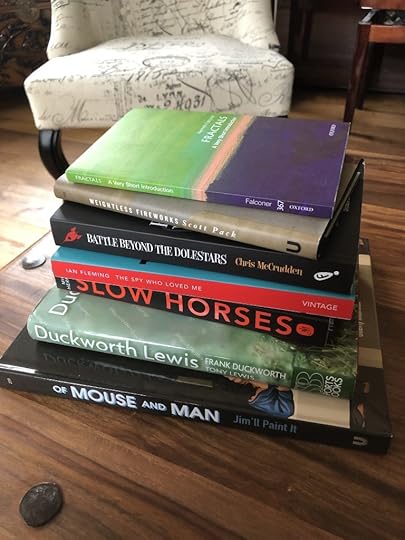
Duckworth Lewis by Frank Duckworth and Tony Lewis This was recommended to me by my Twitter relation Matt Pinnock (no relation really, or not as far as I know), so I feel slightly bad in saying that I was a little disappointed. There’s a really interesting story hidden in there somewhere about how a couple of proper hardcore professional geeks came up with a formula for fairer targets in rain-interrupted limited-over cricket matches, and then somehow managed to sell it to a cricket establishment who clearly didn’t understand a single word they were saying. But there are a number of problems with it. To start with, as a mathematician (retd) myself, I found their explanation of the formula lacking (presumably it’s all about curve-fitting, but unless I missed it, there wasn’t anything about what process led them to the particular curve family they chose), so God knows what anyone else made of it. There was also a slightly peevish tone to the writing which irritated me. Still, it’s an odd little curio of a book and worth a look if the intersection of maths and cricket interests you as much as it does me.
Slow Horses by Mick Herron I’d heard so many people raving about the Slough House series that I decided it was about time I dived in myself, and what a treat this was. Imagine le Carré, only even more downbeat and sleazy. Absolutely lovely stuff and I’ve already bought the next in the series. I believe it’s coming to Apple+ next year, with Gary Oldman in the lead. Might be worth shelling out for a subscription just for that.
The Spy Who Loved Me by Ian Fleming Oh God. We’re up to Bond #10 now, and this is a bit of an odd one. I think Fleming must have been getting a bit bored by now as he’s made a real attempt to break the formula this time. The gimmick is that the story is told from the point of view of the Bond Girl, and in fact our double 0’d chum doesn’t actually make an appearance until nearly two-thirds of the way through. What this means in effect is that we are subjected to a whole swathe of rather tedious backstory before we get to any action, and when the action actually happens, it all comes to a rather unsatisfying premature climax. Oh well, not far to go now. Four more and we’re done.
Battle Beyond the Dolestars by Chris McCrudden Farrago Book pimping alert! OK, this one comes from my publishers, but even if it didn’t, I’d still be recommending it. This is the sequel to 2018’s Battlestar Suburbia and I think it’s even better. I get the feeling that McCrudden is settling into his characters in this one and it’s a very entertaining read indeed. Very funny and more than a little camp, this series is carving out a curious niche for itself, and I’m keen to read more.
Weightless Fireworks by Scott Pack Collection of haiku that I supported via Unbound. Absolutely gorgeous artifact of a book and perfect for dipping into, a page every day or so. So obviously because I’m a heathen idiot, I read the whole thing in a couple of sittings. I’d normally recommend that everyone should buy a copy, but as it’s a limited edition and sold out, I’ll just thumb my nose and say, yah boo sucks, you can’t. And no, you can’t have mine either.
Fractals: A Very Short Introduction by Kenneth Falconer Research and therefore tax deductible. Useful refresher course for any authors who might be writing about fractals for some reason. I hadn’t come across these books before, but there seem to be THOUSANDS of them on every subject under the sun. I think I may read the lot.
Of Mouse and Man by Jim’ll Paint It Another Unbound book that I pledged to, although a world away from Weightless Fireworks. First book by internet phenomenon Jim’ll Paint It, and it’s very funny indeed and astonishingly skilled, too. How anyone can come up with images like these using just MS Paint is beyond me, but I’m very glad that he does.
The post What I Read in October (No, Really) appeared first on Jonathan Pinnock - Writer of Stuff.
October 1, 2019
What I Read in September
Well, I briefly had a plan to blog about other stuff, but I’m sure you’ll be pleased to know that I am devoting most of my writing energies to Book 3 in the Mathematical Mysteries series, leaving me very little time for anything else. Which is a shame, because I did actually write half of a post responding to my friend Kate Nash’s Twitter thread on What People Are Reading (basically because it seemed to be saying that no-one’s reading anything funny and I found that more than a little disturbing) but I didn’t have time to finish it before the show had moved on out of town.
Anyway, the Fractal Monks are proceeding well, and if you feel me buzzing slightly, it’s because the writing speed has just temporarily increased to 2000 words per day. It definitely has some good bits in it, but whether or not they add up to anything like a whole yet, I cannot say. But if you like alpacas, you’ll definitely go for this one.
So here’s what I read this month.
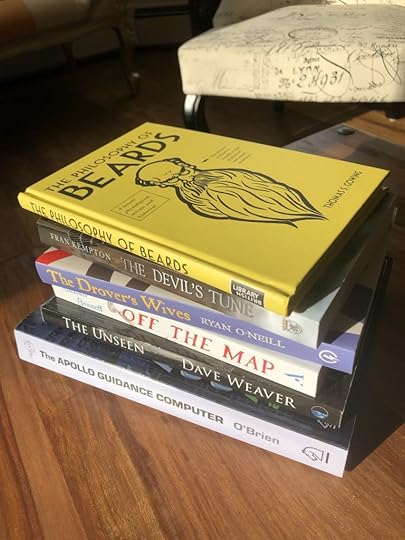
The Unseen by Dave Weaver. Full disclosure: Dave is a mate of mine from Verulam Writers Circle days (and, yes, I know the name’s changed to Verulam Writers, but it’ll always be a circle to me, so there). I remember him reading some palaeolithic drafts of this back in the day when I was still a member of VWC and it’s really good to see it in print. Excellent, really creepy stuff with plenty of authentic chills.
Off the Map by Alistair Bonnett. Non-fiction book about weird, uncharted (can I say “liminal”? Oh go on, then, liminal) places, ranging from places like Sealand (which, as readers of A QUESTION OF TRUST will probably have realised, is a source of great fascination to me), through cruise ships for the super-rich, to the dogging sites of the A31. A slightly more discursive and intellectual version of the sort of stuff that Simon Garfield does so well. I thoroughly enjoyed it.
The Drover’s Wives by Ryan O’Neill. Oh, this is fun. It’s basically an updated version of Raymond Queneau’s famous Exercises in Style, whereby O’Neill takes a (frankly pretty tiresome) famous Australian short story, The Drover’s Wife, and re-tells it in more ways than you can possibly imagine, including the colours on a paint chart and – every author’s favourite – a question posed by an audience member. As with his previous book, Their Brilliant Careers, it’s a neat idea executed perfectly and with impressive attention to detail. Also like TBC, it’s a book that I wished I’d written myself, but I’m quite glad that I didn’t, because I wouldn’t have done it a tenth as well. Incidentally, as well as Queneau’s original, Matt Madden’s graphic novel 99 Ways to Tell a Story: Exercises in Style is also worth checking out.
The Apollo Guidance Computer by Frank O’Brien. Ah. I’m a bit embarrassed by this, because I failed to complete it. In fact, I hardly got anywhere with it, which is particularly bad as I was given it for Christmas by my son (sorry if you’re reading this, Mark). It should have been the perfect gift as it combines my teenage passion for the moon landings with my fascination with early computers. However, despite the memories it brought back of machine code programming on a PDP 8/e, I have to say it was a very, very dry read and I ended up thinking that life was probably a little too short to be spending too many more hours on it.
The Devil’s Tune by Fran Kempton. Full disclosure: Jean Bennett aka Fran Kempton is a friend of mine and also a fellow Austen botherer. Fascinating historical novel of murder and revenge involving everyone’s favourite lunatic psychopath and chromatic composer, Prince Carlo Gesualdo. Also features a cameo by Caravaggio, so really what more could you ask for?
The Philosophy of Beards by Thomas S. Gowing. Mad Victorian treatise in support of the wearing of beards, apparently originally given as a live lecture and then turned into a book before being resurrected a century or so later as a toilet book by the British Library and given to me a few Christmases ago. It will join my already absurdly large collection of daft toilet books, but I’m not sure I’ll be spending much time with it again. It was quite short, anyway.
Now I happen to have a spare hardback copy of Ryan O’Neill’s Their Brilliant Careers (basically because Eye/Lightning books sent a free one out along with The Drover’s Wives, and I’ve already got one), so I am offering it free of charge to one lucky person from the UK. Usual rules – either RT my tweet about this blog post or add a comment below, and you’ll be put into the draw at the end of the month.
Until next time, bye!
The post What I Read in September appeared first on Jonathan Pinnock - Writer of Stuff.
September 5, 2019
What I Read in August
Before we dive into my August reading, I’ve just realised that I haven’t done the draw for that free copy of Paul Flower’s excellent THE GREAT AMERICAN CHEESE WAR. So I’d better do that first. We had a total of nine entries, mostly via Twitter RTs rather than here, which probably says something, although I don’t know what. One of the RTs was me and another was the publishers (who presumably have enough copies already), so that leaves seven. Here we go…
*drum roll*
*keeps on drumming*
*come on, come on*
And the winner is…
*more drum roll*
*even more drum roll, possibly with added cowbell*
*manic drum cadenza, followed by abrupt fade*
Joanna Rollings AKA @SpotSnoopy on Twitter!

I have a spare copy of another splendid book to give away next month, incidentally, so keep your eyes peeled for the “What I Read in September” post some time at the beginning of October, and we’ll do this all again.
One more thing before we do the August books. Given that this blog is supposed to be about my writing, I’d better fill you in on how the Fractal Monks are coming along. After a somewhat trying start to the year, I’m making good progress on Book Three, and it’s still on course for publication in April 2020. I’ve got to the point where I’m really enjoying writing it and I can’t wait to see what happens. Such is the joy of being a pantser rather than a plotter, even if my spell checker keeps insisting on me being a panther, which is possibly even more exciting. One day I may plot a book from the start, just to see what it’s like, but for now I’m going to carry on winging it, on the basis that if I don’t know what’s going to happen, sure as hell my readers won’t.
So this is what I read in August:
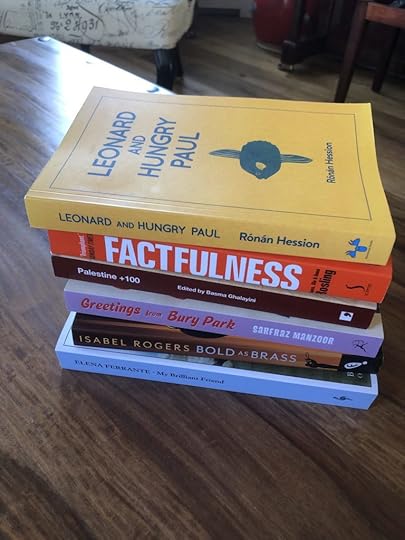
Let’s crack on, shall we?
My Brilliant Friend by Elena Ferrante. I’m usually a bit wary of coming-of-age stories, because, frankly, they tend to follow a fairly predictable path, and once you’ve read a few of them, the template gets a bit boring. But this was something else altogether. I don’t think I’ve ever seen the weird dynamics of childhood relationships observed quite so well as this, amplified by a gloriously subtle twist right at the end. I’ll definitely be reading the rest of this series.
Bold as Brass by Isabel Rogers. The long-awaited (well, a few months awaited, actually – they’re bloody slave-drivers at Farrago, I tell you) sequel to the excellent Life, Death and Cellos, this is – if anything – even better. Rogers really knows her characters, and I don’t think I’ve read anything else that captures the particular oddness of amateur musicians quite so well.
Greetings from Bury Park by Sarfraz Manzoor. Been meaning to acquire this one for ages, mainly because it has THE BEST TITLE EVAH. I finally got around to it this month after being nudged by the publicity surrounding the film based on it, Blinded by the Light. I enjoyed it, but not quite as much as I’d hoped and I think this is because I’ve been spoilt by Imran Ahmad’s lesser-known memoir Unimagined (or The Perfect Gentleman, if you’re in the US), which somehow contrives to be both wittier and more profound. Or maybe it’s just because I only possess one Springsteen album – even if it is Nebraska, which is probably the only one you need.
Palestine +100, edited by Basma Ghalayini. Comma Press have a brilliant track record in producing unusual anthologies from unexpected sources, and this is no exception – a collection of science fiction stories by Palestinian authors, no less. I’ll admit that I ordered it for the sheer novelty value, but I did enjoy reading it as well. I particularly liked Saleem Haddad’s Song of the Birds, which reminded me of something Christopher Priest might have written.
Factfulness by Hans Rosling. I used to enjoy watching the late author’s Gapminder videos, and I was looking forward to getting my hands on a copy of his posthumous book. This is one of those books that I think every single person on the planet should read, if only to remind ourselves that – despite all appearances – the world is actually getting to be a better place, and that it will continue to improve, but only if we pay attention to facts rather than our feelings. Absolutely magnificent and unbelievably timely book. Get yourself a copy now.
Leonard and Hungry Paul by Rónán Hession. Ah. Now there’s been a lot of love for this one on social media, and I really wanted to join in myself. I know why it’s so appealing – it’s because it’s reassuring to come across a novel that celebrates quietness as a virtue in these difficult times. But. But but but. It didn’t work for me. If I were to try to unpick why, maybe it’s because I found that the plot meandered too much or that much of the dialogue seemed unrealistic for my liking or perhaps that one of the characters seemed a bit too close to a manic pixie dream girl for comfort. (Actually, maybe that last one is just a personal thing, because I have a character myself who keeps wanting to become a MPDG and I never quite know whether or not I’ve managed to restrain her.) Alternatively it may simply be that I couldn’t get Nicola Murray’s “Quiet bat people” from The Thick of It out of my head when I was reading it. However, your mileage may very well vary. I know I’m in the minority here.
The post What I Read in August appeared first on Jonathan Pinnock - Writer of Stuff.
August 12, 2019
Cover #3
I might have said this before, but if there’s one thing more exciting than having a single book published, it’s having a series of books published with matching covers. Covers are so important – even when, as I am these days, you’re primarily in the digital market. So I feel particularly fortunate that with Farrago, I have ended up with a publisher who is exceptionally good at picking cover designs.
All of which is by way of introduction to this beauty, which Mark Swan aka kid-ethic has once again put together for Book 3, THE RIDDLE OF THE FRACTAL MONKS. Isn’t it amazing?
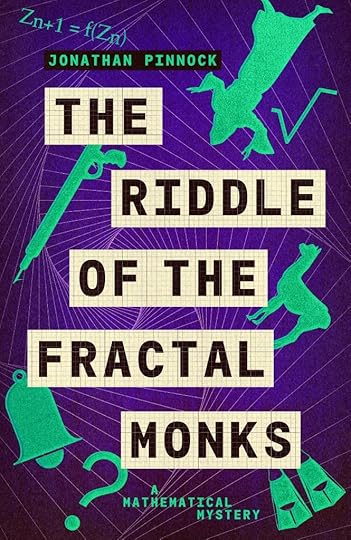
Guess I’d better finish writing the thing, then…
In other news, I’ve just spotted a lovely video review for DIP FLASH (remember that?) on Katie Lumsden’s Books and Things YouTube channel. I’ve embedded it on the DIP FLASH review page here. Whilst I was checking out her channel, I also realised she’d reviewed some other books of mine over the last couple of years, so I’ve added them to their respective review pages, too. (Thanks, Katie!)
The post Cover #3 appeared first on Jonathan Pinnock - Writer of Stuff.
August 2, 2019
What I Read in July
Well, I hope you’re enjoying this newly revitalised blog, with all the varied content that I’ve been putting up since “What I Read in June.”
OK, OK, I know.
As it happens, quite a lot has been happening with my own writing recently. I’ve been working on Book Three of the Mathematical Mysteries, which now has a new title: THE RIDDLE OF THE FRACTAL MONKS. Snappy, eh? Even more importantly, this book already has a cover, but I’m not allowed to reveal it to you for another week. But trust me, it’s just as awesome as (possibly even more awesome than) the first two in the series.
July also saw an exciting 99p/99c promotion for A QUESTION OF TRUST, which I probably should have told you about, but then everyone reading this has probably got at least three copies of the book already – no? The most exciting bit was when it briefly touched #141 in the Amazon US Kindle store and was #1 in humour. Sorry, humor. Heady days.
Anyway, time to look at what I read last month. Make sure you stay till the end, where there’s a giveaway. Don’t we all love a freebie?
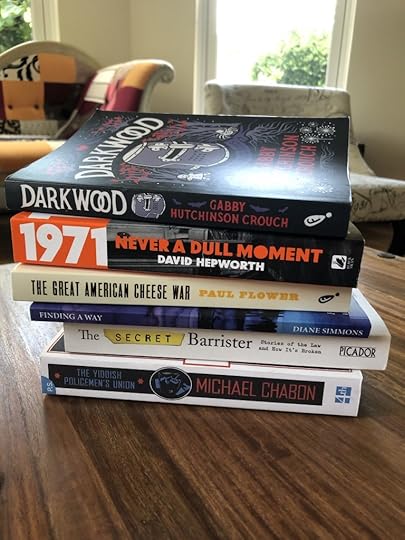
The Yiddish Policemen’s Union by Michael Chabon. This was my third Chabon, after Wonder Boys and The Amazing Adventures of Kavalier and Clay, and I think it’s probably my favourite so far. The only problem is that, as with all Chabon, he’s just too bloody talented. He can do proper comedy, his literary qualities are second to none, and he can also – as evidenced here – do the whole world-building thing as well as anyone. All of this means that reading a Chabon book can be a little exhausting. But well worth it.
The Secret Barrister by … um … The Secret Barrister. One of the two non-fiction books that everyone seems to be reading this summer (the other being James O’Brien’s How to be Right, which I read in June). Deeply alarming report on the state of Britain’s judicial system – hell of an eyeopener, and highly recommended.
Finding a Way by Diane Simmons. This is a short book of flashes on the subject of grief, based on the author’s own personal experience. I’ll be honest – I bought this partly out of a sense of loyalty, because I know Diane and I wanted to support her first publication. But I wasn’t entirely sure what I’d make of it. However, Simmons (let’s be appropriately formal here) has a sure, light touch and what could have been a grim experience turned out to be unexpectedly uplifting. Remarkable book.
The Great American Cheese War by Paul Flower. Broad satire on guns, militias and right-wing US politics, the first of two books this month from the greatest little publisher on the planet. This was great fun and at times utterly inspired. Now as it happens, I have accidentally acquired an extra copy of this book, and if you fancy reading it yourself, please do leave a comment below and I’ll put you in the draw. UK readers only – sorry.
1971 Never a Dull Moment by David Hepworth. Very entertaining jaunt through the music of 1971, which the author claims is the best year ever. It’s a fairly preposterous claim and most of the music and musicians he writes about are somewhat mainstream, but he does dig up some fascinating anecdotes. Currently in the two for £5 pile in HMV, by the way.
Darkwood by Gabby Hutchinson Crouch. The second book from Farrago this month – technically for kids, but, frankly, far too good to be kept just for them. I absolutely loved this – worthy of Pratchett in his mid-period pomp. Buy this one, read it first for yourself and then read it to your kids. And if you haven’t any kids of suitable age, borrow one. Bin Night will never be the same.
Right, that’s it. Remember, if you fancy a free copy of The Great American Cheese War (UK readers only), drop me a line below. And watch out for the cover reveal next week!
The post What I Read in July appeared first on Jonathan Pinnock - Writer of Stuff.



